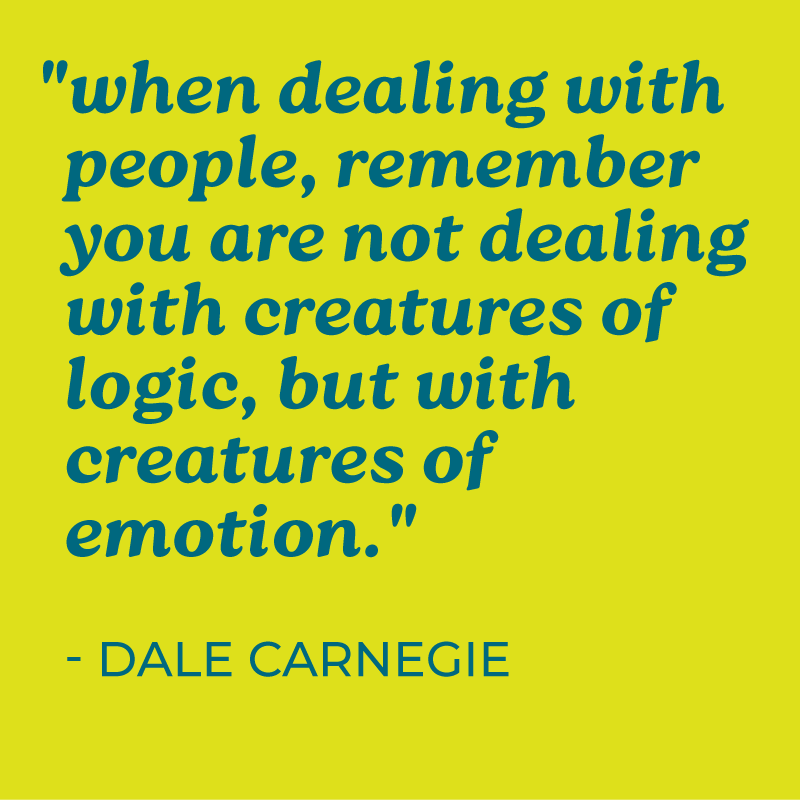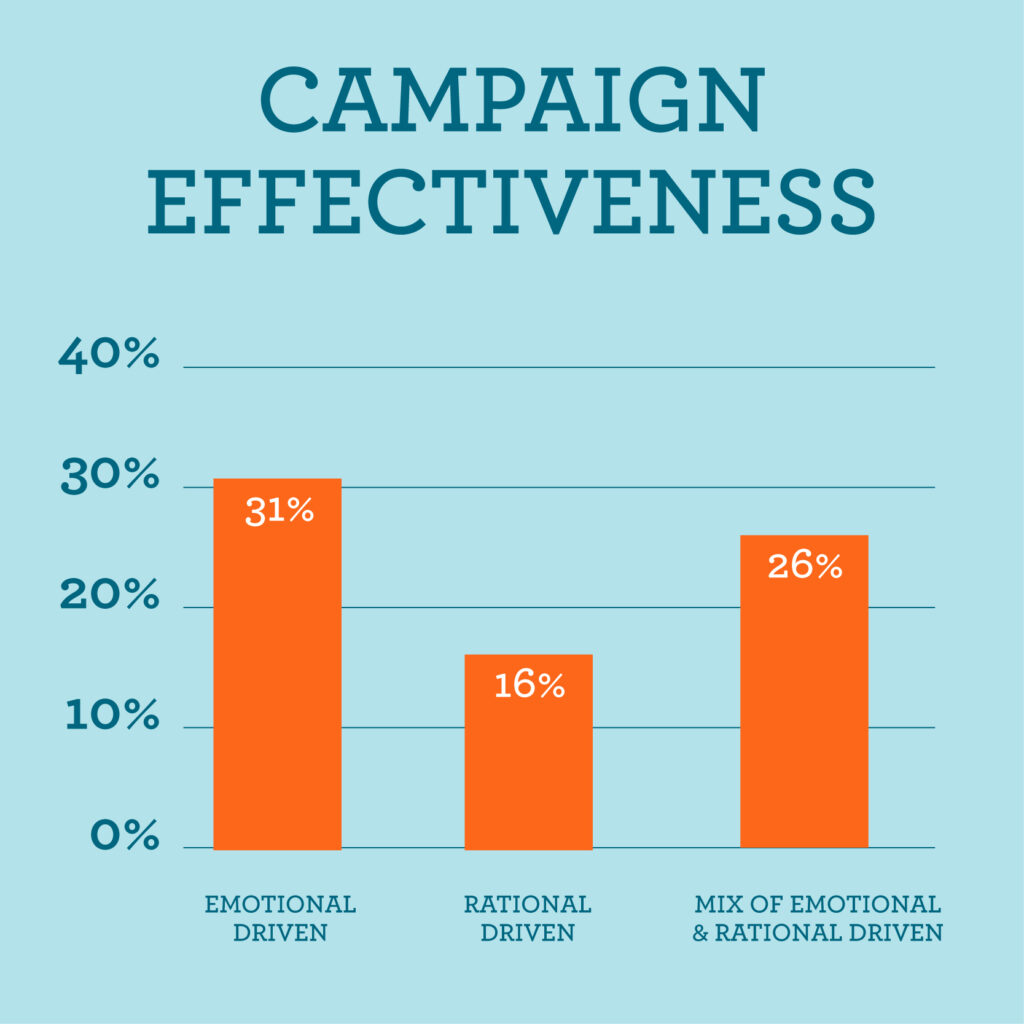In the dynamic world of brand marketing and advertising, where countless products are vying for shoppers’ attention, the power of emotion stands tall as an unrivaled force. While the importance and value of establishing an emotional connection with target consumers is anything but new, it is a most essential one…and when done right, can serve as the secret sauce that transforms an ordinary encounter with a shopper into an inspiring and memorable experience.
 In recognition of the crucial role that emotion plays in the formation of brand architecture, personality and programs, not to mention in forming connections with shoppers, we’ve assembled a quick refresher on its strategic value for winning new customers and nurturing meaningful, long-lasting relationships.
In recognition of the crucial role that emotion plays in the formation of brand architecture, personality and programs, not to mention in forming connections with shoppers, we’ve assembled a quick refresher on its strategic value for winning new customers and nurturing meaningful, long-lasting relationships.
Psychology at Work
Unlike rational appeals that lean heavily into product information for persuasion, emotional-driven marketing/advertising is designed to resonate on a visceral level – with it taking an understanding of the psychology of the customer to achieve this. This means knowing what’s important to them, what motivates them, etc., to ensure that the emotional levers and tone being used are relevant to help the target audience identify with and form a meaningful, memorable impression about the brand.
Psychologically, emotions play a significant role in forming memories, and advertisements that evoke strong emotions are more likely to be remembered and influence decision making. It is the connection between emotion and memory that reinforces brand essence in the consumer’s mind, making it a powerful tool that ideally should lead the customer to thoughts of “that’s me…this brand knows me…I connect with them.”
An example of the role played by psychology and emotions in forming connections between shoppers and brands is found in Amazon’s recent “Sledding” holiday campaign, a TV commercial laden with emotional nostalgia. Aside from its entertainment value, the spot serves to establish Amazon as much more than a convenient shopping platform, but rather as a reliable partner that delivers happiness, and through its products and service, helps create memories.
Amazon “Sledding” Commercial
The Power of Emotional Connection
 The secret of why psychology and emotion in advertising wields influence rests in its ability to tug at our desires and aspirations, reflect a lifestyle or feeling with which we (seek to) identify, and through creative imagery and words, create a lasting impression that inspires us to want to actually experience a brand in its fullest.
The secret of why psychology and emotion in advertising wields influence rests in its ability to tug at our desires and aspirations, reflect a lifestyle or feeling with which we (seek to) identify, and through creative imagery and words, create a lasting impression that inspires us to want to actually experience a brand in its fullest.
A recent analysis from UK-based Institute of Practitioners in Advertising quantifiably illustrates the power emotional-driven advertising holds in guiding consumer decision-making. Drawing from a database of 1,400 case studies of successful advertising campaigns spanning 3 decades, the data showed that campaigns with purely emotional content generated nearly twice the profitability boost (31% vs. 16%) as those with only rational content, and also delivered stronger results than those containing a mix of emotional and rational content.
Capturing the Right Emotion Takes Knowing the Brand and Customer
Whether developing a social media post, print ad or package, brands need to be selling the emotional value of their product to help form a deeper connection with shoppers. To properly do this, they must first get to know their customer as well as their own brand. Let’s start with the brand and the important components it holds for creating emotional dimension. For starters, there’s the brand personality. Research reveals that consumers perceive the same personality traits and characteristics in brands as they do in people. So, just like with human relationships, certain consumers are attracted to some brand personality types more than others. That said, it’s important for brands to clearly define who they are, what they are about and how they want their audience to perceive them. With that in hand, they will be prepared to create a relevant, supportable brand persona which can then be communicated through brand packaging, visual imagery, messaging and more.
Speaking of messaging, another key foundational element for establishing emotion can be found in the brand “narrative”—the story that communicates “who” the brand is, what it means to the consumer, and why the consumer should care. That said, it’s important to make every word count when crafting the brand story and messaging to ensure they collectively paint an accurate and audience-relevant picture. For example, a food brand operating in the premium organic space might consider using phrases such as “farm-to-table fresh,” “harvested by generational family farmers,” and “crafted in small-batches” to create a feeling of authenticity and suggest that their product is ideal for those seeking a lifestyle dedicated to wholesome, natural goodness. Clearly, helping consumers understand what a brand is about through emotionally driven content and creative imagery is what truly elevates the game and enables the customer to ‘experience’ the brand on a much higher, more personal level.
Finally, in order for brands to fully connect with their target shoppers, they must first look to psychology to understand who their customer is and what makes them tick. This means going beyond demographic information and conducting research to gain deeper insight into the target shopper’s lifestyle, what they value in the products they buy, what are their unmet needs within the product category, where they shop, what is the experience they seek in using the product category, what associations do they hold about the brand and its competitors, and more. With that information in hand, a brand will have insight into the psychological and emotional mindset of their customer and will be strategically prepared to create a more relevant emotionally-driven platform for connection building.
 The “Find Zen in Your Pen” brand platform and animal-spokesperson for Zebra Pen was designed to deliver a fun, energized brand personality that is both memorable and conveys that the brand understands and elevates consumers’ personal journey of self-expression, whatever their pen needs might be.
The “Find Zen in Your Pen” brand platform and animal-spokesperson for Zebra Pen was designed to deliver a fun, energized brand personality that is both memorable and conveys that the brand understands and elevates consumers’ personal journey of self-expression, whatever their pen needs might be.
Other Considerations: Emotional Tone, Trust, and Authenticity
Whether it’s with humor, nostalgia, or something else, leveraging the proper emotional tone in advertising is another way that brands can elevate the appeal and engagement of campaigns with their target. With different emotions resonating with different audiences, brands should carefully consider the emotional tone they wish to project, working to ensure that it not only aligns with the values and aspirations of their target shoppers, but that it also accurately reflects the brand’s own essence to establish a stronger, more relevant connection.
For example, an organic food brand aimed at health and eco-conscious shoppers might consider leveraging imagery of lush green fields and family farmers in its advertising to evoke a feeling of authenticity and trust among target shoppers, while a trendy new salty snack directed at young adults might embody a hip party-scene vibe to more effectively connect with its consumers.
 Research from the Institute of Neuroscience and Psychology at the University of Glasgow found that we have only four basic emotions: happy, sad, fear/surprise and disgust/anger. So, determine which feeling you intend to inspire, and consistently leverage it across copy, graphics, photos, music, etc.
Research from the Institute of Neuroscience and Psychology at the University of Glasgow found that we have only four basic emotions: happy, sad, fear/surprise and disgust/anger. So, determine which feeling you intend to inspire, and consistently leverage it across copy, graphics, photos, music, etc.
Providing consistency in emotional tone is another key ingredient for building strong, trusted relationships with shoppers, and one that helps shape a more concrete identity for the brand. Delivering authentic emotion is also important, given that transparency and sincerity serve to strengthen the bond between brand and consumer. This is especially true for Millennial and GenZ audiences who give high rankings to brand authenticity as a factor influencing purchase.
The Ripple Effect of Emotion
Integrating the right psychological and emotional elements into brand advertising is much more than a process…it’s a brand building opportunity that when done properly can help to exponentially build awareness and grow sales. Emotional connections established through advertising can transform ordinary consumers into passionate brand advocates. When individuals feel a deep emotional resonance with a brand, they are more likely to become brand advocates and share their experiences with others, with this ripple effect expanding the reach of emotional connection to others.
In the competitive landscape of advertising, the power of emotion is truly a force to be reckoned with. Emotional-driven advertising creates a bond between brands and consumers that transcends well beyond the sales transaction. Through understanding of the psychology of shoppers and appealing to their emotions, brands can create advertising campaigns filled with personality and feeling that resonate on a deeper, more profound level, leaving lasting impact and building trust with their audience, so they, in turn, will think, “that’s me…they get me…I want that brand.” No doubt, as brands continue to navigate the ever-evolving landscape of consumer preferences, harnessing the power of emotion will remain a timeless and indispensable strategy.
Establishing psychological and emotional links in advertising efforts is not a secret strategy, but clearly an essential one. The first step to capturing the proper emotion for your brand begins with more than just knowing your brand, but understanding your customer – what they value, how they feel, what they need, and what motivates them. For in the end, a customer-centric strategy will always serve to inspire brand purchase and devotion.
*Source: Neuroscience Marketing


